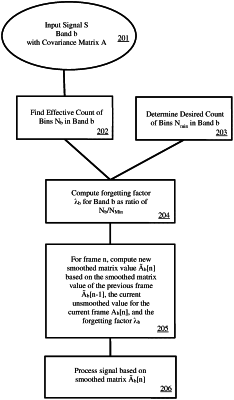| CPC G10L 19/008 (2013.01) [G10L 19/26 (2013.01); G10L 21/0208 (2013.01); G10L 25/18 (2013.01); G10L 2021/02082 (2013.01)] | 20 Claims |

|
1. A method of providing an audio service, the method comprising:
for a time-domain sequence of signal frames, comparing an effective count of bins in a frequency band to a desired count of bins for the frequency band;
computing a forgetting factor for the frequency band as a ratio of the effective count to the desired count;
for each frequency band of a plurality of frequency bands, in response to determining that the effective count of bins in the frequency band is smaller than the desired count, generating a respective smoothed band-specific covariance matrix for a present signal frame using a previously generated value of the respective smoothed band-specific covariance matrix for a previous signal frame relative to the present signal frame and the forgetting factor; and
generating an audio signal for the audio service using frequency domain representations of the time-domain sequence of signal frames and further using corresponding sets of the respective smoothed band-specific covariance matrices,
wherein the comparing, computing, and generating are performed by a system including one or more computer processors.
|